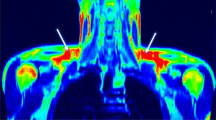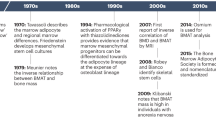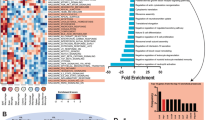Abstract
Brown adipose tissue (BAT) is capable of transforming chemically stored energy, in the form of triglycerides, into heat. Recent studies have shown that metabolically active BAT is present in a large proportion of adult humans, where its activity correlates with a favorable metabolic status. Hence, the tissue is now regarded as an interesting target for therapies against obesity and associated diseases such as type 2 diabetes, the hypothesis being that an induction of BAT would be beneficial for these disease states. Apart from the association between BAT activity and a healthier metabolic status, later studies have also shown a positive correlation between BAT volume and both bone cross-sectional area and bone mineral density, suggesting that BAT might stimulate bone anabolism. The aim of this review is to give the reader a brief overview of the BAT research field and to summarize and discuss recent findings regarding BAT being a potential player in bone metabolism.
This is a preview of subscription content, access via your institution
Access options
Subscribe to this journal
We are sorry, but there is no personal subscription option available for your country.
Buy this article
- Purchase on Springer Link
- Instant access to full article PDF
Prices may be subject to local taxes which are calculated during checkout
Similar content being viewed by others
References
Grundlingh J, Dargan PI, El-Zanfaly M, Wood DM . 2,4-dinitrophenol (DNP): a weight loss agent with significant acute toxicity and risk of death. J Med Toxicol 2011; 7: 205–212.
Colman E . Dinitrophenol and obesity: an early twentieth-century regulatory dilemma. Regul Toxicol Pharmacol 2007; 48: 115–117.
Boström P, Wu J, Jedrychowski MP, Korde A, Ye L, Lo JC et al. A PGC1-alpha-dependent myokine that drives brown-fat-like development of white fat and thermogenesis. Nature 2012; 481: 463–468.
Cederberg A, Grønning LM, Ahren B, Tasken K, Carlsson P, Enerbäck S . FOXC2 is a winged helix gene that counteracts obesity, hypertriglyceridemia, and diet-induced insulin resistance. Cell 2001; 106: 563–573.
Seale P, Conroe HM, Estall J, Kajimura S, Frontini A, Ishibashi J et al. Prdm16 determines the thermogenic program of subcutaneous white adipose tissue in mice. J Clin Invest 2011; 121: 96–105.
Enerbäck S . Human brown adipose tissue. Cell Metab 2010; 11: 248–252.
Virtanen KA, Lidell ME, Orava J, Heglind M, Westergren R, Niemi T et al. Functional brown adipose tissue in healthy adults. N Engl J Med 2009; 360: 1518–1525.
van Marken Lichtenbelt WD, Vanhommerig JW, Smulders NM, Drossaerts JM, Kemerink GJ, Bouvy ND et al. Cold-activated brown adipose tissue in healthy men. N Engl J Med 2009; 360: 1500–1508.
Cypess AM, Lehman S, Williams G, Tal I, Rodman D, Goldfine AB et al. Identification and importance of brown adipose tissue in adult humans. N Engl J Med 2009; 360: 1509–1517.
Lee P, Greenfield JR, Ho KK, Fulham MJ . A critical appraisal of the prevalence and metabolic significance of brown adipose tissue in adult humans. Am J Physiol Endocrinol Metab 2010; 299: E601–E606.
Saito M, Okamatsu-Ogura Y, Matsushita M, Watanabe K, Yoneshiro T, Nio-Kobayashi J et al. High incidence of metabolically active brown adipose tissue in healthy adult humans: effects of cold exposure and adiposity. Diabetes 2009; 58: 1526–1531.
Lee P, Zhao JT, Swarbrick MM, Gracie G, Bova R, Greenfield JR et al. High prevalence of brown adipose tissue in adult humans. J Clin Endocrinol Metab 2011; 96: 2450–2455.
Ouellet V, Routhier-Labadie A, Bellemare W, Lakhal-Chaieb L, Turcotte E, Carpentier AC et al. Outdoor temperature, age, sex, body mass index, and diabetic status determine the prevalence, mass, and glucose-uptake activity of 18F-FDG-detected BAT in humans. J Clin Endocrinol Metab 2011; 96: 192–199.
Matsushita M, Yoneshiro T, Aita S, Kameya T, Sugie H, Saito M . Impact of brown adipose tissue on body fatness and glucose metabolism in healthy humans. Int J Obes (Lond) 2014; 38: 812–817.
Bredella MA, Gill CM, Rosen CJ, Klibanski A, Torriani M . Positive effects of brown adipose tissue on femoral bone structure. Bone 2014; 58: 55–58.
Bredella MA, Fazeli PK, Freedman LM, Calder G, Lee H, Rosen CJ et al. Young women with cold-activated brown adipose tissue have higher bone mineral density and lower Pref-1 than women without brown adipose tissue: a study in women with anorexia nervosa, women recovered from anorexia nervosa, and normal-weight women. J Clin Endocrinol Metab 2012; 97: E584–E590.
Lee P, Brychta RJ, Collins MT, Linderman J, Smith S, Herscovitch P et al. Cold-activated brown adipose tissue is an independent predictor of higher bone mineral density in women. Osteoporos Int 2013; 24: 1513–1518.
Ponrartana S, Aggabao PC, Hu HH, Aldrovandi GM, Wren TA, Gilsanz V . Brown adipose tissue and its relationship to bone structure in pediatric patients. J Clin Endocrinol Metab 2012; 97: 2693–2698.
Lidell ME, Betz MJ, Dahlqvist Leinhard O, Heglind M, Elander L, Slawik M et al. Evidence for two types of brown adipose tissue in humans. Nat Med 2013; 19: 631–634.
Cannon B, Nedergaard J . Brown adipose tissue: function and physiological significance. Physiol Rev 2004; 84: 277–359.
Fedorenko A, Lishko PV, Kirichok Y . Mechanism of fatty-acid-dependent UCP1 uncoupling in brown fat mitochondria. Cell 2012; 151: 400–413.
Orava J, Nuutila P, Lidell ME, Oikonen V, Noponen T, Viljanen T et al. Different metabolic responses of human brown adipose tissue to activation by cold and insulin. Cell Metab 2011; 14: 272–279.
Mortola JP, Merazzi D, Naso L . Blood flow to the brown adipose tissue of conscious young rabbits during hypoxia in cold and warm conditions. Pflugers Arch 1999; 437: 255–260.
Gesta S, Tseng YH, Kahn CR . Developmental origin of fat: tracking obesity to its source. Cell 2007; 131: 242–256.
Seale P, Bjork B, Yang W, Kajimura S, Chin S, Kuang S et al. PRDM16 controls a brown fat/skeletal muscle switch. Nature 2008; 454: 961–967.
Vitali A, Murano I, Zingaretti MC, Frontini A, Ricquier D, Cinti S . The adipose organ of obesity-prone C57BL/6J mice is composed of mixed white and brown adipocytes. J Lipid Res 2012; 53: 619–629.
Wang QA, Tao C, Gupta RK, Scherer PE . Tracking adipogenesis during white adipose tissue development, expansion and regeneration. Nat Med 2013; 19: 1338–1344.
Wu J, Boström P, Sparks LM, Ye L, Choi JH, Giang AH et al. Beige adipocytes are a distinct type of thermogenic fat cell in mouse and human. Cell 2012; 150: 366–376.
Lee YH, Petkova AP, Mottillo EP, Granneman JG . In vivo identification of bipotential adipocyte progenitors recruited by beta3-adrenoceptor activation and high-fat feeding. Cell Metab 2012; 15: 480–491.
Harms M, Seale P . Brown and beige fat: development, function and therapeutic potential. Nat Med 2013; 19: 1252–1263.
Kajimura S, Saito M . A new era in brown adipose tissue biology: molecular control of brown fat development and energy homeostasis. Annu Rev Physiol 2014; 76: 225–249.
Kajimura S, Seale P, Spiegelman BM . Transcriptional control of brown fat development. Cell Metab 2010; 11: 257–262.
Peirce V, Carobbio S, Vidal-Puig A . The different shades of fat. Nature 2014; 510: 76–83.
Rosen ED, Spiegelman BM . What we talk about when we talk about fat. Cell 2014; 156: 20–44.
Marko O, Cascieri MA, Ayad N, Strader CD, Candelore MR . Isolation of a preadipocyte cell line from rat bone marrow and differentiation to adipocytes. Endocrinology 1995; 136: 4582–4588.
Thorns C, Schardt C, Katenkamp D, Kähler C, Merz H, Feller AC . Hibernoma-like brown fat in the bone marrow: report of a unique case. Virchows Arch 2008; 452: 343–345.
Kumar R, Deaver MT, Czerniak BA, Madewell JE . Intraosseous hibernoma. Skeletal Radiol 2011; 40: 641–645.
Krings A, Rahman S, Huang S, Lu Y, Czernik PJ, Lecka-Czernik B . Bone marrow fat has brown adipose tissue characteristics, which are attenuated with aging and diabetes. Bone 2012; 50: 546–552.
Calo E, Quintero-Estades JA, Danielian PS, Nedelcu S, Berman SD, Lees JA . Rb regulates fate choice and lineage commitment in vivo. Nature 2010; 466: 1110–1114.
Olmsted-Davis E, Gannon FH, Ozen M, Ittmann MM, Gugala Z, Hipp JA et al. Hypoxic adipocytes pattern early heterotopic bone formation. Am J Pathol 2007; 170: 620–632.
Gilsanz V, Chung SA, Jackson H, Dorey FJ, Hu HH . Functional brown adipose tissue is related to muscle volume in children and adolescents. J Pediatr 2011; 158: 722–726.
Kim JK, Kim HJ, Park SY, Cederberg A, Westergren R, Nilsson D et al. Adipocyte-specific overexpression of FOXC2 prevents diet-induced increases in intramuscular fatty acyl CoA and insulin resistance. Diabetes 2005; 54: 1657–1663.
Rahman S, Lu Y, Czernik PJ, Rosen CJ, Enerbäck S, Lecka-Czernik B . Inducible brown adipose tissue, or beige fat, is anabolic for the skeleton. Endocrinology 2013; 154: 2687–2701.
Bennett CN, Longo KA, Wright WS, Suva LJ, Lane TF, Hankenson KD et al. Regulation of osteoblastogenesis and bone mass by Wnt10b. Proc Natl Acad Sci USA 2005; 102: 3324–3329.
Cawthorn WP, Bree AJ, Yao Y, Du B, Hemati N, Martinez-Santibanez G et al. Wnt6, Wnt10a and Wnt10b inhibit adipogenesis and stimulate osteoblastogenesis through a beta-catenin-dependent mechanism. Bone 2012; 50: 477–489.
Kawai M, Breggia AC, DeMambro VE, Shen X, Canalis E, Bouxsein ML et al. The heparin-binding domain of IGFBP-2 has insulin-like growth factor binding-independent biologic activity in the growing skeleton. J Biol Chem 2011; 286: 14670–14680.
Rosen CJ . Insulin-like growth factor I and bone mineral density: experience from animal models and human observational studies. Best Pract Res Clin Endocrinol Metab 2004; 18: 423–435.
Abe E, Yamamoto M, Taguchi Y, Lecka-Czernik B, O'Brien CA, Economides AN et al. Essential requirement of BMPs-2/4 for both osteoblast and osteoclast formation in murine bone marrow cultures from adult mice: antagonism by noggin. J Bone Miner Res 2000; 15: 663–673.
Jiang X, Song D, Ye B, Wang X, Song G, Yang S et al. Effect of intermittent administration of adiponectin on bone regeneration following mandibular osteodistraction in rabbits. J Orthop Res 2011; 29: 1081–1085.
Takeda S, Elefteriou F, Levasseur R, Liu X, Zhao L, Parker KL et al. Leptin regulates bone formation via the sympathetic nervous system. Cell 2002; 111: 305–317.
Elefteriou F, Ahn JD, Takeda S, Starbuck M, Yang X, Liu X et al. Leptin regulation of bone resorption by the sympathetic nervous system and CART. Nature 2005; 434: 514–520.
Motyl KJ, Rosen CJ . Temperatures rising: brown fat and bone. Discov Med 2011; 11: 179–185.
Sviderskaya EV, Novak EK, Swank RT, Bennett DC . The murine misty mutation: phenotypic effects on melanocytes, platelets and brown fat. Genetics 1998; 148: 381–390.
Blasius AL, Brandl K, Crozat K, Xia Y, Khovananth K, Krebs P et al. Mice with mutations of Dock7 have generalized hypopigmentation and white-spotting but show normal neurological function. Proc Natl Acad Sci USA 2009; 106: 2706–2711.
Motyl KJ, Bishop KA, DeMambro VE, Bornstein SA, Le P, Kawai M et al. Altered thermogenesis and impaired bone remodeling in Misty mice. J Bone Miner Res 2013; 28: 1885–1897.
Moseley KF . Type 2 diabetes and bone fractures. Curr Opin Endocrinol Diabetes Obes 2012; 19: 128–135.
Dede AD, Tournis S, Dontas I, Trovas G . Type 2 diabetes mellitus and fracture risk. Metabolism 2014; 63: 1480–1490.
Acknowledgements
MEL is supported by the Swedish Research Council (2013-4466). SE is supported by the Swedish Research Council (2012-1652 and 2014-2516), The Knut and Alice Wallenberg Foundation, Sahlgrenska’s University Hospital (LUA-ALF), European Union grants (HEALTH-F2-2011-278373; DIABAT), the Inga Britt and Arne Lundgren Foundation, the Söderberg Foundation, and the King Gustaf V and Queen Victoria Freemason Foundation.
Disclaimer
This article is published as part of a supplement sponsored by the Université Laval’s Research Chair in Obesity, in an effort to inform the public on the causes, consequences, treatments and prevention of obesity.
Author information
Authors and Affiliations
Corresponding author
Ethics declarations
Competing interests
MEL and SE declare no conflicts of interest.
Rights and permissions
About this article
Cite this article
Lidell, M., Enerbäck, S. Brown adipose tissue and bone. Int J Obes Supp 5 (Suppl 1), S23–S27 (2015). https://doi.org/10.1038/ijosup.2015.7
Published:
Issue Date:
DOI: https://doi.org/10.1038/ijosup.2015.7
This article is cited by
-
Clinical Pharmacology of Elagolix: An Oral Gonadotropin-Releasing Hormone Receptor Antagonist for Endometriosis
Clinical Pharmacokinetics (2020)
-
Association between brown adipose tissue and bone mineral density in humans
International Journal of Obesity (2019)
-
Diets High in Fat or Fructose Differentially Modulate Bone Health and Lipid Metabolism
Calcified Tissue International (2017)
-
Physiological determinants and impacts of the adipocyte phenotype
International Journal of Obesity Supplements (2015)



